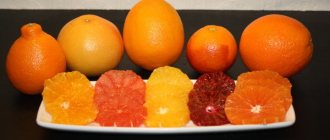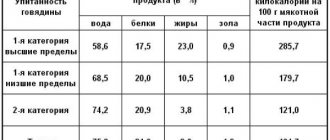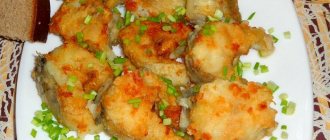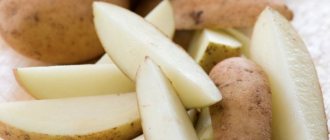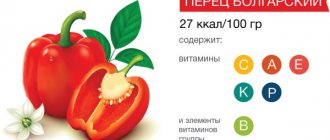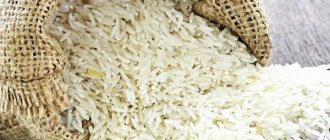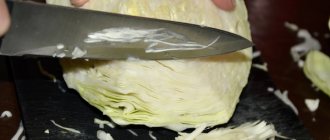Composition of mandarin
Tangerines (calorie content per 100 grams are quite low) have the following composition:
| Vitamin content | |
| Vitamin A | ˂60 mcg |
| Vitamin B1 | ˂60 mcg |
| Vitamin B2 | 30-35 mcg |
| Vitamin B3 | 0.35 mg |
| Vitamin B4 | 10 mg |
| Vitamin B5 | ˂200 mcg |
| Vitamin B6 | 80 mcg |
| Vitamin B8 | 190 mg |
| Vitamin B9 | 16 mcg |
| Vitamin C | ˂40 mg |
| Vitamin P | ˂30 mg |
Minerals:
| Potassium | 150-170 mg |
| Calcium | 35 mg |
| Phosphorus | 15-20 mg |
| Magnesium | 11-12 mg |
| Sodium | 1.5-2 mg |
| Iron | 0.1-0.15 mg |
Calorie content and composition
Tangerine contains a rich set of useful and nutritious substances, in particular vitamin A, C, B vitamins, potassium, calcium, iron and phosphorus. 100 g of fresh fruit without peel contains 38 kcal.
The calorie content of one tangerine with peel ranges from 47 to 53 kcal, depending on the variety and degree of ripening of the product.
Tangerine peel contains 35 kcal per 100 g.
The calorie content of dried tangerine, depending on the variety, is 270 - 420 kcal per 100 g, dried - 248 kcal.
Nutritional value of tangerine pulp per 100 grams of product:
- proteins – 0.8 g;
- fats – 0.2 g;
- carbohydrates – 7.5 g;
- dietary fiber – 1.9 g;
- water – 88 g;
- ash – 0.5 g;
- organic acids – 1.1 g.
The composition of tangerine peel per 100 grams of product contains:
- proteins – 0.9 g;
- fats – 2 g;
- carbohydrates – 7.5 g.
The ratio of proteins, fats and carbohydrates in tangerine pulp is 1: 0.3: 9.4, respectively.
Vitamin composition of tangerine
Mandarin contains the following vitamins:
| Vitamin | Quantity | Benefits for the body | |
| Vitamin A | 10 mcg | It has antioxidant properties, improves vision, skin and hair condition, strengthens the immune system, regulates protein synthesis, and normalizes metabolism. | |
| Beta carotene | 0.06 mg | Synthesizes vitamin A, has an antioxidant effect, improves vision, strengthens the immune system, and promotes bone tissue regeneration. | |
| Vitamin B1, or thiamine | 0.06 mg | Regulates carbohydrate, fat and protein metabolism, promotes nervous stimulation, protects cells from the effects of toxic substances. | |
| Vitamin B2, or riboflavin | 0.03 mg | Strengthens the nervous system, regulates metabolism, participates in the formation of red blood cells, protects mucous membranes. | |
| Vitamin B4, or choline | 10.2 mg | Normalizes the functioning of the nervous system, removes toxins, restores liver cells. | |
| Vitamin B5, or pantothenic acid | 0.216 mg | Participates in the oxidation of carbohydrates and fatty acids, synthesizes glucocorticoids, normalizes the functioning of the nervous system, improves the condition of the skin, and participates in the formation of antibodies. | |
| Vitamin B6, or pyridoxine | 0.07 mg | Synthesizes nucleic acids, improves the functioning of the nervous system, promotes hemoglobin synthesis, and reduces muscle spasms. | |
| Vitamin B9, or folic acid | 16 mcg | Participates in the formation of all cells of the body, in the synthesis of enzymes and amino acids, supports the normal course of pregnancy and the formation of the fetus. | |
| Vitamin C, or ascorbic acid | 38 mg | It has antioxidant properties, strengthens the immune system, protects the body from bacteria and viruses, regulates hormone synthesis and hematopoietic processes, participates in collagen synthesis, and normalizes metabolism. | |
| Vitamin E, or alpha-cotopherol | 0.2 mg | It has antioxidant properties, slows down the aging process of cells, improves vascular tone and tissue regeneration, reduces body fatigue, normalizes blood sugar levels, and prevents the development of cancerous tumors. | |
| Vitamin H, or biotin | 0.8 µg | Participates in carbohydrate and protein metabolism, regulates blood sugar levels, strengthens the nervous system, improves skin condition and hair structure, participates in the synthesis of hemoglobin, and normalizes oxygen metabolism. | |
| Vitamin PP, or nicotinic acid | 0.3 mg | Regulates lipid metabolism, improves the functioning of the nervous system, reduces cholesterol levels in the blood. | |
| Niacin | 0.2 mg | Dilates blood vessels, improves microcirculation, participates in amino acid metabolism, normalizes the functioning of the cardiovascular system, strengthens the nervous system, participates in the synthesis of hormones, and helps absorb plant proteins. | |
The combination of all the vitamins in tangerine has a complex effect on the body, improving the functioning of organs and systems, normalizing metabolism and strengthening the immune system. The fruit is necessary for the prevention of viral diseases and vitamin deficiency.
© bukhta79 — stock.adobe.com
Macro- and microelements
Mandarin contains macro- and microelements necessary for the treatment and prevention of various diseases, strengthening the immune system and the body’s resistance to bacteria and viruses.
100 grams of product contains the following macroelements:
| Macronutrient | Quantity | Benefits for the body |
| Potassium (K) | 155 mg | Promotes the removal of waste and toxins, normalizes the functioning of the cardiovascular system. |
| Calcium (Ca) | 35 mg | Forms bone and dental tissue, makes muscles elastic, regulates the excitability of the nervous system, and participates in blood clotting. |
| Silicon (Si) | 6 mg | Forms connective tissue, improves the strength and elasticity of blood vessels, normalizes the functioning of the nervous system, improves the condition of the skin, hair and nails. |
| Magnesium (Mg) | 11 mg | Participates in carbohydrate and protein metabolism, normalizes cholesterol levels in the blood, and relieves spasms. |
| Sodium (Na) | 12 mg | Regulates acid-base and electrolyte balance, normalizes excitability and muscle contraction, improves brain activity. |
| Sulfur (S) | 8.1 mg | Disinfects blood and helps fight bacteria, removes toxins, cleanses blood vessels, improves blood circulation. |
| Phosphorus (P) | 17 mg | Promotes the formation of hormones, forms bones, normalizes metabolism, improves brain activity. |
| Chlorine (Cl) | 3 mg | Promotes the removal of salts from the body, participates in lipid metabolism, prevents the deposition of fats in the liver, and improves the composition of red blood cells. |
Microelements in 100 g of tangerines:
| Microelement | Quantity | Benefits for the body |
| Aluminum (Al) | 364 mcg | Normalizes the processes of growth and development of bone and epithelial tissue, activates enzymes and stimulates the functioning of the digestive glands. |
| Boron (B) | 140 mcg | Improves the strength of bone tissue and participates in its formation. |
| Vanadium (V) | 7.2 mcg | Participates in lipid and carbohydrate metabolism, regulates cholesterol levels in the blood, stimulates the movement of blood cells. |
| Iron (Fe) | 0.1 mg | Participates in the processes of hematopoiesis, is part of hemoglobin, normalizes the functioning of the muscular system and nervous system, helps fight fatigue and weakness of the body, and increases vitality. |
| Iodine (I) | 0.3 mcg | Regulates metabolism, stimulates the immune system. |
| Cobalt (Co) | 14.1 mcg | Takes part in DNA synthesis, breaks down proteins, fats and carbohydrates, stimulates the growth of red blood cells, normalizes adrenaline levels. |
| Lithium (Li) | 3 mcg | Activates enzymes and prevents the development of cancer tumors, has a neuroprotective effect. |
| Manganese (Mn) | 0.039 mg | Regulates oxidation processes and metabolism, reduces cholesterol levels in the blood, and prevents the deposition of lipids in the liver. |
| Copper (Cu) | 42 mcg | Participates in the formation of red blood cells and collagen synthesis, improves the condition of the skin, helps synthesize iron into hemoglobin. |
| Molybdenum (Mo) | 63.1 mcg | Regulates enzymatic activity, synthesizes vitamins, improves blood quality, and promotes the elimination of uric acid. |
| Nickel (Ni) | 0.8 mcg | Participates in the activation of enzymes and in the processes of hematopoiesis, regulates sugar levels and enhances the effect of insulin, helps preserve the structure of nucleic acids, and participates in oxygen metabolism. |
| Rubidium (Rb) | 63 mcg | Activates enzymes, regulates the functioning of the nervous system, has an antihistamine effect, and relieves inflammation in the cells of the body. |
| Selenium (Se) | 0.1 mcg | Strengthens the immune system, slows down the aging process, and prevents the appearance of cancer. |
| Strontium (Sr) | 60 mcg | Helps strengthen bone tissue. |
| Fluorine (F) | 150.3 mcg | Strengthens bones and tooth enamel, helps remove radicals and heavy metals from the body, stimulates hair and nail growth, strengthens the immune system. |
| Chromium (Cr) | 0.1 mcg | Participates in carbohydrate and lipid metabolism, regulates cholesterol levels in the blood. |
| Zinc (Zn) | 0.07 mg | Normalizes blood sugar levels, strengthens the immune system and prevents viruses and bacteria from entering the body. |
Digestible carbohydrates:
- glucose – 2 g;
- sucrose – 4.5 g;
- fructose – 1.6 g.
Saturated fatty acids – 0.039 g.
Polyunsaturated fatty acids:
- omega-3 – 0.018 g;
- omega-6 – 0.048 g.
Amino acid composition:
| Essential and non-essential amino acids | Quantity |
| Arginine | 0.07 g |
| Valin | 0.02 g |
| Histidine | 0.01 g |
| Isoleucine | 0.02 g |
| Leucine | 0.03 g |
| Lysine | 0.03 g |
| Threonine | 0.02 g |
| Phenylalanine | 0.02 g |
| Aspartic acid | 0.13 g |
| Alanin | 0.03 g |
| Glycine | 0.02 g |
| Glutamic acid | 0.06 g |
| Proline | 0.07 g |
| Serin | 0.03 g |
| Tyrosine | 0.02 g |
The benefits and harms of tangerine
Mandarin contains most of the vitamins and minerals the body needs to maintain immunity at a high level. Components such as potassium and sodium help relieve swelling. Glycosides prevent the development of atherosclerosis of blood vessels.
Essential oils promote the production of endorphins. Phenolic acid actively helps in the treatment of diseases of the respiratory system. Fruit extract is often used in cosmetics for dry and aging skin due to its nourishing and moisturizing effects.
Also, the main beneficial properties of tangerine include:
- prevention of respiratory diseases;
- decreased blood pressure;
- tonic effect;
- improved digestion;
- prevention of helminthiasis.
Mandarin is widely known as an ingredient in medicinal folk recipes. Fresh fruit juice helps with intestinal disorders and constipation.
To get rid of nausea, you should eat the peel of the fruit. Rubbing tangerine juice into the skin helps prevent fungal diseases. Syrups containing tangerine have proven themselves effectively in the treatment of bronchial diseases. The benefits of this fruit are not comparable to the harm that can only be caused by excessive consumption .
Beneficial properties of tangerine
The fruit of the tangerine tree has high taste and is widely popular. Many people use tangerine to enjoy its taste and aroma, without paying attention to the beneficial properties of the fruit. But regardless of the purpose of use, tangerine has a positive effect on the functioning of the body.
The healing and beneficial effects of tangerine are manifested as follows:
- the fruit regulates blood sugar levels and enhances the action of insulin, preventing the development of type 2 diabetes;
- promotes weight loss;
- restores bone tissue and helps strengthen it;
- reduces cholesterol levels in the blood and prevents the development of atherosclerosis;
- strengthens blood vessels and improves blood circulation;
- has anti-inflammatory and antimicrobial properties;
- fights scurvy and other manifestations of vitamin deficiency;
- strengthens the nervous system;
- preserves the integrity of neurons;
- reduces the formation of carcinogenic compounds;
- promotes the removal of heavy metals from the body.
Tangerines are good for digestion. The chemical composition of the product stimulates intestinal motility, improves the secretion of gastric juice enzymes, and cleanses the digestive tract of toxins.
With fruit pulp, the body receives a large amount of vitamin C, which is necessary to strengthen the immune system. The fruit is especially useful in winter, when the supply of vitamins from natural sources decreases and the body’s ability to resist viruses and bacteria deteriorates.
B vitamins contained in the fetus normalize the functioning of the nervous system and help fight stress. These vitamins act effectively in combination, which means that consuming tangerines will have a beneficial effect on the nervous system.
Mandarin is useful for pregnant women whose bodies are in dire need of vitamins. Folic acid, which is part of the product, has a beneficial effect on the health of the woman and the unborn child.
Attention! Pregnant women should eat the fruit with caution and in limited quantities. Despite the vitamin composition, the product can cause an allergic reaction and a number of other negative consequences. Before consuming tangerine, you should consult your doctor.
Mandarin helps relieve swelling and inflammation. Regular consumption of the fruit prevents the development of cancerous tumors.
The minerals contained in the pulp help strengthen muscles and make them more elastic. The product will bring invaluable benefits to athletes. Tangerine can be used as a light snack before training, which will fill the body with useful substances, increase endurance and performance.
Benefits for women
The benefit of tangerines for the female body lies in the low calorie content of the fruit. The product helps fight excess weight, since one kilogram of fruit contains 380 kcal. The low calorie content of tangerine causes the body to expend more calories consumed. Regular consumption of fruits normalizes metabolism in the body and promotes rapid fat burning. Thanks to its taste, tangerine can easily replace high-calorie sweets.
For effective weight loss, eat sweet fruits in the morning. In the evening, give preference to protein foods. It is not advisable to eat tangerines at night, since the product contains a lot of carbohydrates.
Mandarin is widely used in cosmetology. Many women appreciated the usefulness of the product for maintaining a healthy appearance.
Biologically active substances in the product have a beneficial effect on the skin:
- Improves skin cell regeneration.
- Fights acne and acne.
- They have antifungal properties.
- Smoothes out wrinkles.
- Prevents skin aging.
There is a wide range of cosmetics based on tangerine. In home cosmetology, tinctures and extracts from the peel and pulp of the fruit are used. Tangerine essential oil helps fight inflammation, improves complexion, and is used in aromatherapy and massage.
© zenobillis — stock.adobe.com
Benefits for men
Frequent physical activity typical of men requires a lot of energy and vitality. Regular consumption of tangerines maintains the vitality of the body and increases performance. B vitamins relieve nervous tension and normalize the functioning of the nervous system, improve mental activity, and help fight insomnia.
Tangerines improve the functioning of the digestive system and gastrointestinal tract, improve blood circulation, prevent the development of tumor processes, have a beneficial effect on sexual life, improve blood flow to the genitals, and increase potency.
Contraindications to the use of tangerines
Tangerines should not be consumed by people who have:
- individual intolerance to the fruit or its components;
- tendency to allergic reactions;
- gastritis;
- ulcer;
- nephritis;
- hepatitis;
- cholecystitis;
- diseases of the duodenum;
- high acidity of gastric juice.
Fruits from the citrus family are strong allergens and can therefore cause diathesis. It is not recommended to eat tangerines if you have inflammatory diseases of the digestive system.
Harm and contraindications
Any product, in addition to its beneficial properties, has a number of contraindications. The fruit is contraindicated for people with a number of diseases:
- gastritis;
- hepatitis;
- cholecystitis;
- peptic ulcer of the stomach and intestines;
- inflammatory processes of the gastrointestinal tract.
Citrus fruits are a strong allergen and should be eaten with caution. A large number of tangerines can cause skin rashes.
Children are advised to eat tangerines in moderation so as not to harm the body. The daily norm for a child is no more than two medium-sized fruits.
© Mikhail Malyugin — stock.adobe.com
Calorie content of dried tangerine per 100 g
Tangerines after drying have a calorie content per 100 grams reaching 500 kcal. When preparing dried tangerines, all the vitamins remain in them, and the moisture completely evaporates. In this form, fruits can be stored for a long time and are used in many dishes.
The figure shows the calorie content of tangerines per 100 grams.
It is advisable to wash industrially dried tangerines before eating, as they are treated with substances containing sulfur. If mold appears on the fruit, it is better to refuse to eat it.
Zests
Citrus fruits provide humans not only with refreshing pulp, but also with such an important nutritional component as zest. It is characterized by an orange color and a sweet-sour taste with a slight bitterness. It is the zest that contains the lion's share of the beneficial substances of citrus fruits. First of all, this is ascorbic acid (just 6 g of zest can cover 14% of the daily requirement), followed by other vitamins, flavonoids, macro- and microelements, as well as essential oils.
Tangerine zest can be safely used in cooking. Firstly, it is a surprisingly aromatic seasoning for meat and fish, and also a flavoring agent for baking. Secondly, zest can replace salt, which significantly reduces the calorie content of dishes. It is also used in the preparation of lemonades and other drinks. Another bonus is candied fruits, which are also made from aromatic zest.
It has been scientifically proven that the zest of the fruit can be used as a natural remedy to eliminate swelling, and all thanks to the control over the water-salt balance in the body. The aromatic product also copes well with cholesterol, significantly reducing its level.
The calorie content of the zest is 97 kcal per 100 grams. It should be taken into account that the calorie content changes slightly when making candied fruits - at least 216 kcal per 100 g, if sugar is not used. Otherwise, the calorie content completely increases to 395 kcal for the same 100 g. In addition to sugar, citric acid, salt and water are used to prepare candied fruits at home. For culinary purposes, such preparations can be used in different ways: used as a hearty snack, added to salads or meat dishes, homemade cakes and desserts.
In general, orange fruit zest is beneficial for weight loss. For example, white “veins” are rich in nobiletin, a flavonoid that helps in removing fat deposits from the body. Also, consuming zest, especially fresh, can speed up metabolism, relieve stress and make cellulite less pronounced.
How does tangerine help you lose weight?
The issue of losing weight has always been relevant for women, and tangerines are good helpers in this matter. The fat content in this fruit is very low, so it can be safely included in the diet. The advantage is the diuretic effect of tangerine and the fact that it is quickly digested by the body.
With a low calorie content, the fruit contains a lot of useful substances that help keep the body in good shape and not gain weight. The fruit is great for daytime snacking and replaces high-calorie desserts, but you should limit yourself to 3-4 tangerines per day.
Scientists have proven that flavonoids in citrus fruits help fight excess weight. Tangerines also speed up metabolic processes in the body, which is important for weight loss. The big advantage is that tangerines can be eaten almost all year round. Nevertheless, the organic acids in the fruit can provoke an increase in appetite, so it should be consumed in moderation.
Calorie content of peel and zest
When determining your calorie intake, it is important to calculate the nutritional value of each meal, including snacks. Often people ignore the need to count the calorie content of all foods that enter the body. Because of this, it becomes difficult to calculate the exact caloric content of the diet.
When using peels and zests, it is necessary to take into account that, regardless of the variety, they contain 34-38 kcal.
There is no need to stop eating the crust. Some people add it to baked goods, others make candied fruits or use it in making infusions. The peel and zest contain beta-carotene, vitamins A and P, which are necessary to improve heart function and prevent disorders in the functioning of the vascular system. Also includes:
- glycosides;
- phytoncides;
- pectin;
- cellulose;
- organic acids.
We recommend that you read: Tangerine poisoning
Regular consumption of tangerines with the skin prevents the formation of cholesterol plaques. This method of eating fruits helps normalize digestion and relieve cough.
Is it possible to eat tangerines in the evening while losing weight?
It is advisable to eat tangerines in the morning or before lunch due to their high content of simple sugars and carbohydrates. This product is not one of the lowest calorie and dietary products, but 1-2 fruits a day will only benefit the body. If you eat tangerines at night, carbohydrates can be deposited in unwanted extra pounds.
But if dinner consists of tangerine in combination with protein foods, this will prolong the feeling of fullness and slow down the process of carbohydrate absorption. This diet will not cause heaviness in the stomach or discomfort. If you are on a strict diet, it is better to eat tangerines no later than 5 pm.
Contraindications
No matter how perfect tangerines are, unfortunately they also have some contraindications. The fact is that an excess amount of fruit eaten can cause allergic reactions (redness, rash, etc.). In addition, there are a number of diseases in which it is necessary to reduce the daily intake of these fruits:
- gastritis (with high acidity);
- cholecystitis;
- diabetes;
- colitis;
- stomach ulcer;
- kidney diseases;
- hepatitis;
- enteritis;
- acute nephritis;
- intestinal diseases;
- diseases of tooth enamel.
As you can see, unfortunately, the list of contraindications is quite long. But don’t rush to get upset and give up these juicy and aromatic fruits, the main thing is to know and observe moderation in everything.
If suddenly you have doubts about any diseases or allergies, then it is better not to take risks, and also do not delay going to the clinic for consultation with a specialist.
It is important to remember that moderate consumption of tangerines can improve your mood, strengthen your immune system, and also normalize your weight.
Tangerine diet: basic principles, menu for 3 days
Mandarin (calorie content per 100 grams is about 35 kcal) includes a large amount of fiber. Thanks to this, digestion processes are accelerated and a feeling of fullness comes. Pectin in the composition gives the body energy, and flavones promote weight loss. The substances contained in tangerine break down fats and speed up metabolism.
Thanks to research, scientists have found that this fruit provokes the burning of fat in the abdominal area and prevents fatty liver.
Tangerine juice is not the most optimal dietary product, but it can still be included in the menu if:
- drink juice in the morning;
- do not combine with high-calorie ingredients;
- consume with fermented milk products.
You should eat no more than 200 g of tangerines per day so as not to disrupt your proper nutrition regimen.
The fruit goes best with the following products:
- porridge (rice, oatmeal);
- low fat meat;
- seafood;
- fruits, berries, other citrus fruits;
- dairy products.
You should not combine tangerines with legumes and dishes containing starch. Regular fasting days with tangerines are one of the effective methods of losing weight. Once a week, you can limit the menu to this fruit, if there are no diseases of the digestive system.
You can eat no more than 1 kg of tangerines per day, while drinking enough water. Fasting days can be repeated 3-4 times a month, on subsequent days limiting your consumption of flour dishes and desserts.
One of the popular ones is the egg-tangerine diet. In 4-5 days you can lose 2-4 kg. Daily diet: 4-5 eggs and 3-4 tangerines. The servings alternate between eggs, tangerines and egg whites. You need to eat every 2 hours, and drink more fluids during breaks.
Sample diet menu with tangerines for 3 days:
| 1 day | breakfast | oatmeal with tangerine slices |
| dinner | boiled chicken, lettuce leaves | |
| dinner | tangerine, glass of kefir | |
| Day 2 | breakfast | rice porridge, tangerine |
| dinner | baked duck with vegetables | |
| dinner | fruit salad | |
| Day 3 | breakfast | salad with seafood and tangerine |
| dinner | boiled eggs, vegetable salad | |
| dinner | cottage cheese, tangerine |
Mandarin can be used as a spice for rice, meat and fish dishes, and in sauces. The fruit can be a component of various salads and baked dishes.
General information about mandarin
These are round, orange-colored fruits, as well as the evergreen trees on which these fruits grow. Plants reach a height of 4-5 m. On average, one tree produces from 600 to 800 fruits per year. The older it is, the more it bears fruit. Mandarin differs from other citrus fruits by its thin peel, which does not adhere to the pulp. It has a pleasant citrus smell and taste. Juicy fruits consist of 10-12 segments with seeds, but some varieties do not have them.
Tangerines are tasty and very healthy fruits for humans.
Composition and calorie content of the fruit
The calorie content of the fruit depends on the degree of ripening and variety. 100 g of fruit contains from 37 to 53 kcal. The composition is dominated by water (85 g) and carbohydrates (13.3 g). Proteins amount to 0.81 g, little fat - 0.31 g. Mandarin contains 26.7 mg of ascorbic acid, which is 38% of the daily value. It contains few vitamins B, PP, E, A, H, and biotin, but the fruit is rich in the following microelements (in mcg per 100 g):
- boron - 140;
- rubidium - 63;
- copper - from 48 to 62;
- molybdenum - 61.3;
- cobalt - 14.1;
- vanadium - 7.2;
- lithium - 3.
Among the macroelements, potassium (166 mg) and silicon (6 mg) predominate. These fruits contain phytosterols (67% of the daily value), which eliminate inflammatory processes in the organs.
Dietary recipes with tangerines
There are many culinary recipes that include tangerines and allow you to maintain your figure.
Hawaiian pudding
Ingredients:
- milk – 1 l;
- rice – 1 glass;
- tangerines – 2 pcs.;
- orange – 1 pc.;
- apple - 1 pc.;
- banana – 1 pc.;
- cherry – 200 g;
- water – 600 ml;
- sugar – 150 g;
- raspberry jam – 1 tbsp;
- vanillin – 1 g.
Bring milk to a boil, add rice and sugar. Cook for 15 minutes over low heat, add vanilla. Stir and leave until the liquid is completely absorbed. Peel the fruits, divide them into slices, cut apples and bananas. Boil fruit syrup and add jam. Place the resulting pudding on a plate, put fruit on top, and pour syrup over it. Serve immediately after serving.
Fruit salad
Compound:
- tangerines – 3 pcs.;
- bananas – 2 pcs.;
- kiwi – 2 pcs.;
- apples – 2 pcs.;
- low-fat yogurt – 100 g.
Peel the fruits, cut into cubes, mix. Season the salad with yogurt. You can sprinkle orange zest on top, decorate with prunes, dried apricots, and nuts. You can add berries depending on the season.
Canned tangerine and apple compote
Ingredients:
- tangerines – 4 large;
- apples – 2 pcs.;
- sugar – 150 g;
- water – 1 l.
Wash and peel the tangerines thoroughly. Cut the peel into thin strips. Divide the tangerine into slices. Peel the apples and cut into cubes. Place zest, apples and tangerine slices into boiling water. Cook for 10 minutes, add sugar, cool. Next, pour the compote into jars and tighten.
Light salad with tangerines
Components:
- chicken fillet – 350 g;
- shrimp – 200 g;
- tangerines – 5 pcs.;
- yogurt – 500 ml;
- celery – 6 pcs.;
- greenery;
- salt.
Boil chicken fillet in salted broth. Cut the meat into small pieces. Wash the celery, peel and cut into cubes. Peel the tangerines and divide into slices. Cook shrimp for 3 minutes. Place the ingredients in a glass, add salt and pour over yogurt. Garnish the salad with fresh herbs.
All of the recipes listed are low in calories and fit well into the diet menu.
Calorie content of dried tangerines
When planning to diversify your diet with dried fruits, you should be careful. This need is due to the fact that they have a high calorie content. 100 grams of dried tangerine fruits contain about 230 kcal. In order for the body to receive this number of calories, you need to eat 5-7 fruits. Candied fruits made from peel and pulp are many times superior in nutritional value to all fresh fruits. Dried candied tangerines can contain more than 520 kcal per 100 g of product.
People who control their caloric intake and watch their figure should not get carried away with even small dried tangerines. The weight of dried fruit can be about 10-20 g, but even 1 fruit is enough to deliver more than 100 kilocalories to the body. It’s difficult to call them useful for people losing weight. They contain a minimal amount of proteins and fats, but too many carbohydrates.
Benefits of fruits
Dried tangerines are prepared by long drying or smoking. But more often on store shelves you can find sweets that are made by boiling fruits in sugar syrup. In such delicacies the content of useful substances will be kept to a minimum, because... Most vitamins disappear during heat treatment.
Dried tangerines, unlike dried and cooked in syrup, retain most of the beneficial substances in their composition. They are recommended for use by those people who need to stimulate the immune system, help the body cope with infections or recover from illness. Dried fruits have a pronounced anti-inflammatory effect on the body.
But in cases when you want something sweet, it is better to eat 2 dried tangerines than several chocolates or other store-bought sweets. You can get the minimum amount of calories and maximum benefits for the body if you include the peels of these citrus fruits in your diet. They help relieve sore throats and relieve coughs and runny noses. This effect is due to the inclusion of a large number of essential oils in their composition.
We recommend that you read: Cleaning Avocados at Home
Dried tangerines are famous for their effect on the body. When used regularly they:
- normalize the functioning of the digestive organs;
- improve the process of nutrient absorption;
- have a beneficial effect on the organs of vision;
- gradually dissolve cholesterol plaques in the vessels, increasing their lumen;
- remove salts and excess cholesterol from the body;
- normalize the functioning of the nervous system, help reduce tension and relieve fatigue;
- stimulate blood circulation;
- increase appetite.
Therefore, people who do not plan to lose weight can safely include them in their diet in small quantities. Do not forget that such tangerines contain more calories than fresh fruits.
Preparation of dried tangerines
You can make a healthy treat at home. To dry the fruits of the tangerine tree:
- in direct sunlight on hot days;
- in the oven;
- in a special dryer for fruits.
You can dry fruits outside provided there is low humidity and temperatures above 25 °C. There is no point in trying to dry them whole; first, the fruits should be peeled and divided into slices. It is better not to break the shell of each of them, so you cannot remove the seeds.
You can receive a useful product after 3-5 days. Tangerines do not spoil in the sun due to the fact that they contain saccharides and citric acid. But it is better to lay them out on wooden surfaces, because... upon contact with aluminum or copper, the oxidation process will begin.
In an electric dryer, it is enough to place the slices on plastic shelves and select a processing program. After a few hours, the fruit will be dried and ready to eat.
It’s a little more difficult to prepare a delicacy in a gas oven. It is important to correctly determine the optimal temperature for drying. You can preserve the maximum of nutrients if you dry the slices at temperatures up to 80 °C. They must be carefully separated and placed on a baking sheet covered with parchment.
When preparing dried fruits yourself, you can be sure that no harmful substances or sugar have been added to them. Also, every culinary specialist knows the number of calories contained in one tangerine, since he is aware that the slices were not dipped in sugar syrup or processed in any other way.
What a quality tangerine should be like: tips for choosing citrus
Different varieties of tangerines differ in:
- taste;
- color;
- aroma;
- acidity.
One of the sweetest fruits is the Pixie variety. It has juicy pulp with virtually no seeds and a peel with pronounced pores. Satsuma tangerines are sweet and sour and have thick skin. Their lobes are of different sizes.
Hybrids of tangerine with grapefruit and orange have greater sweetness and brighter color. Tangerine peels may be treated with harmful chemicals, so it's worth paying attention to their color and texture.
You should not buy fruits if the following are noticeable on the skin:
- white coating;
- stickiness;
- waxy shine;
- damage and bruises;
- brown spots.
Tangerines must be washed before consumption and it is better not to eat the peel, as the fruit is often processed for long-term storage. If the fruit is frozen, the peel looks wrinkled and thin. Fruit infected with parasites has dark spots of rot.
The taste of fruits depends on where they are grown:
- Tangerines from Abkhazia have pronounced acidity, small size, and yellow-orange skin. The fruits are easy to peel and contain few seeds.
- Fruits from Turkey are honey-sweet and contain many seeds. The peel is bright orange and difficult to separate.
- Spanish tangerines are deep orange, sweet and sour, and contain few seeds. The fruits are large, with thick skin.
- Tangerines from Morocco are flattened, with a yellow tint, and seedless. The fruits are sweet and juicy.
- Israeli tangerines are dry, thin-skinned and have a sweet taste.
When buying tangerines, you should pay close attention to their appearance. The fruits must be clean, without spots or streaks. The color of the fruit is uniform. The peel should not be shiny or sticky. The richer the color of the tangerine, the sweeter its taste. If you lightly press the skin, the juice should come out.
Large tangerines have a sour taste. The fruit should have a fresh citrus aroma. The fruit should be elastic and without damage. Mandarin (calorie content of fruit per 100 grams is 35 kcal) is a healthy and valuable fruit that must be included in a healthy diet.
How to choose sweet tangerines
In any hypermarket you will find dozens of types: Abkhazian, Turkish and Moroccan. They differ in size, rich taste, sweetness and the presence of seeds. Sweet tangerines are classified as Spanish, Israeli and Moroccan, while tangerines are classified as Abkhazian, Georgian, and Turkish.
Simple recommendations on how to choose a sweet tangerine if you don’t want to suffer on New Year’s Eve with a bad peel or squint from excess acidity:
- the best way is to try a slice before buying;
- pay attention to the appearance: the sweet, ripe fruit is covered with a “porous” peel, easy to peel. It does not fit tightly to the fruit; a small gap remains between it and the pulp;
- the peel is whole, without tears, not dried out or softened, without moldy streaks. If the seller convinces you that mold is only on top, or offers a discount, refuse: the slices will also taste mold, which is forbidden to be eaten, especially by children;
- sweet tangerines - soft, but at the same time elastic;
- color - uniform and rich, bright orange.
shutterstock.com
Applications of tangerine
Did you know that it is recommended to eat tangerines whole, that is, together with the white mesh? The fact is that it is rich in substances such as glycosides, which strengthen the walls of blood vessels. Actually, you shouldn’t throw away the peel, it’s also very useful. It contains a large amount of essential oils, flavonoids, organic acids, as well as vitamin C and carotene. You probably think that all this is not true, because we are used to always throwing away the peels after eating a tangerine.
It has been proven that a decoction made from tangerine peel and honey stimulates the absorption of food and also improves the production of gastric secretions, and is also incredibly tasty. You can also make candied fruits from tangerine peel, which are an excellent substitute for candy.
The main scope of application and use of tangerine:
- fresh;
- in the preparation of jellies, pies, muffins and fruit salads;
- they cook aromatic jam, compotes, and also make freshly squeezed juices;
- you can dry feijoa fruits and then add them to teas and decoctions;
- in fish, poultry, rice and even sauces.
Composition and benefits of the product
Like any other citrus, tangerine is enriched with vitamins C. The high content of ascorbic acid not only helps strengthen the immune system, but also has a preventive effect on the oral cavity from the development of any pathological processes of inflammatory etiology, and also accelerates regeneration processes in the event of wounds and burns .
It is important to know that mandarin also contains flavonoids necessary for the human body, which ensure the elimination of toxins, waste and free radicals.
The peel of the fruit in question contains a high concentration of vitamins A and P. In addition, the fruit is rich in pectin, fiber, phytoncides and glycosides, which undoubtedly have benefits for the entire human body. The nutritional value of tangerine is that it contains 0.8 grams of protein, 7.5 grams of carbohydrates and only 0.2 grams of fat. Moreover, the sugar content is 11% of the total mass of the whole fruit. The range of beneficial qualities of tangerines does not end there. Their use is simply necessary to maintain full human health.
Video
Because they contribute to:
- replenishment of the vitamin complex lost by the body during the winter period and acceleration of recovery processes for flu and colds;
- softening cough and restoring metabolism;
- providing an anti-edematous effect and ensuring the removal of mucus during bronchitis or asthma, due to the content of phenolic acid;
- preventing the formation and development of atherosclerosis and other heart pathologies;
- toning the body and providing a calming effect on the central nervous system.
It is also worth noting that tangerines are useful not only for weight loss, but also during pregnancy. Eating 1-2 tangerines daily will help replenish vitamin C reserves, and regular massage using essential oils based on these fruits will help prevent the appearance of stretch marks in the expectant mother.
Use for weight loss
The tangerine diet, which involves including these fruits in the daily diet, is considered effective. It is recommended to consume 1 kg of citrus fruits per day: at one time you can eat 3-4 fruits and a small amount of low-fat protein product: cottage cheese, boiled meat, fish, yoghurt, kefir products, egg whites. You should eat at least 5 times a day.
During diet therapy, you need to control the amount of fluid consumed: it should be about 2 liters per day. It is recommended to drink pure mineral water.
Ascorbic acid, along with physical exercise, actively burns fat, which promotes the degeneration of adipose tissue into muscle tissue. Therapeutic nutrition should be combined with moderate physical activity. If you do everything correctly, you can lose more than 5 kg of weight in 10 days.
The tangerine diet helps cleanse the intestines, remove excess fluid from the body, normalize metabolic processes and restore the balance of nutrients.
To consolidate the result, it is recommended to carry out an anti-cellulite massage using tangerine peel. Essential oils have a pronounced tightening effect. They are added to lotions and used during massage procedures.
How to choose?
A healthy tangerine is a ripe, bright, aromatic, juicy and attractive fruit.
I can easily say that when choosing citrus fruits, you just need to start from appearance and aroma. Before buying tangerines, you should carefully inspect them for damage, dents, rotten spots and soft areas. In order to find out the degree of ripeness of the fruit, there is one simple and proven trick - you need to press a little on the peel. If juice appears on the zest, this means that the tangerine is ripe.
- Turkish tangerines are small fruits that differ from their counterparts in their yellowish-green hue. The pulp is sweet and sour with a high content of seeds.
- Moroccan tangerines - these fruits have a bright orange peel, there are no seeds in the pulp, and the taste is sweet.
- Spanish tangerines are large fruits with thick, lumpy and porous bright orange skin. The pulp of this tangerine is sweet, juicy and contains a minimal number of seeds.
Benefits of tangerine for men
- The presence of citric and ascorbic acids, magnesium, zinc, potassium and phosphorus in citrus helps to normalize the functioning of the prostate gland and maintain the acidity level of the ejaculate.
- These fruits are very useful for smokers, as vitamin C helps the body fight oxygen starvation, and it also neutralizes toxic substances.
- A balanced complex of micro- and macroelements, as well as vitamins, accelerates the body’s recovery process after excessive strength loads.
Tangerines for children
Since tangerine is characterized by an extremely high degree of allergenicity, it is forbidden to give this fruit to a child younger than 6 months. After 12 months, you can begin to introduce 1-2 slices into the diet with a gradual increase (provided that everything went away without allergies).
Most pediatricians insist on increasing these age limits from 1 year to 1.5. This is all due to the symptoms of allergies, which manifest themselves not only in the redness of the cheeks, but also in the internal state of the body. A child under one year old is not yet able to describe his feelings.
If all feedings have passed without negative consequences, then from the age of 3 you can already give a whole tangerine, but not every day (it is better to alternate fruits).
Tangerine essential oil
Today, the oil is very widely used in cosmetology, perfumery, folk medicine and aromatherapy. Typically, to obtain tangerine essential oil, its peel is used, it is pressed and distilled using steam.
Tangerine oil effectively fights the appearance of “orange peel” (cellulite), smoothes wrinkles, maintains skin tone and eliminates stretch marks, and also treats acne.
When there is a surge in flu and ARVI epidemics, doctors most often recommend using aroma lamps with tangerine oil at home. This is because this remedy has an antiseptic and antispasmodic effect, which is so necessary for loss of strength and colds.
Mandarin, where are you from?
It is believed that the birthplace of these sweet citrus fruits is northeast India. Biologists suggest that the first tangerine trees appeared 3,000 years ago. From India, mandarin “migrated” to China, then to Europe, the countries of North Africa and Australia.
At the beginning of the 19th century, two varieties of this tree came to England, then they spread throughout the Mediterranean countries, and from there to the American continent. Today this plant is most common in Japan, southern China, India, the East Indies, Australia, the USA, and Mexico. But still, the main supplier of these sweet fruits is China, where approximately half of the world's tangerine crop is grown. Every year the Chinese collect 25-30 million tons of these fruits.
